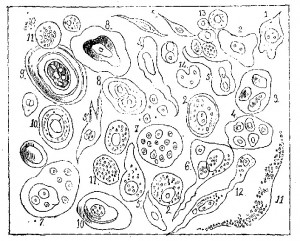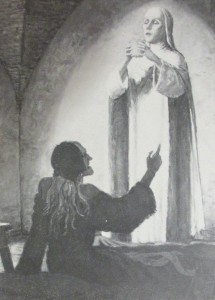 Fanny H. Brotons is a PhD candidate at the Institute of History of the Spanish National Research Council. Her dissertation focuses on the experience of Spanish and British cancer sufferers in the second half of the nineteenth century. In this blog post she explores how science and religion contributed to different definitions of the disease, and emotional reactions to it, including revulsion and fear, prior to the twentieth century.
Fanny H. Brotons is a PhD candidate at the Institute of History of the Spanish National Research Council. Her dissertation focuses on the experience of Spanish and British cancer sufferers in the second half of the nineteenth century. In this blog post she explores how science and religion contributed to different definitions of the disease, and emotional reactions to it, including revulsion and fear, prior to the twentieth century.
Fanny is a member of the group HIST-EX, which studies the history and philosophy of emotions and experience. During the academic year 2013-2014, she was a visiting researcher in the Department of History, Classics & Archaeology of Birkbeck, University of London. You can follow Fanny on Twitter: @fannyhbrotons.
Cancer has existed as a medical diagnosis since Antiquity. The Hippocratic corpus (5th – 4th centuries BCE) coined the terms karkinos and karkinoma for referring to non-healing lumps and sores. The Roman physician Galen (2nd century CE) translated these names into the Latin word cancer and further described the disease within the long-lasting framework of humoralism. Cancer and fear have been inextricably entangled ever since, and physicians themselves are often the first to be held responsible for the terrifying diagnosis, when it comes.
Through the centuries, medical treatises defined cancer as the epitome of malignant tumours: painful, incurable, and deadly. Moreover, they often compared its course with the pattern of behaviour of an aggressive animal. It adhered to the tissues of the organism with the obstinacy of a crab seizing a prey in its claws. It recurred after the most thorough surgical excision, in the same way that some crab-like species can regenerate a paw lost in a battle. It was voracious like a wolf (lupus) or gnawing like a rodent (ulcus rodens). Most of the time, it was preferable not to touch it (noli me tangere), as irritation speeded up its dissemination within the body.

“Different form of cells that carcinoma can present”. Badía, Salvador. Del origen del cáncer en relación a su tratamiento. Est. tipográfico de Ramírez y Cia, 1876.
A major difference exists, however, between the descriptions of a fearsome disease and a dreaded illness. Despite the now classic claims of Roy Porter’s medical history from below, the existing historiography of cancer has rarely considered the point of view of the sick people and their environment before the end of the 19th century. The main argument has been that cancer was a relatively rare disease before the changes brought about by two parallel processes. On the one hand, the reconceptualization of the condition as a proliferation of abnormal cells following on from Johannes Müller studies in the late 1830s gave rise to a steady pattern of increase in its incidence and mortality (Fig. 1). On the other hand, advances in public and private hygiene, combined with better nutrition, led to a significant decline in the number of people affected by epidemic diseases (with TB as a model). As a result, cancer became increasingly visible, and subjected to collective forms of fear. (1)
As medical statistics only gained momentum in the nineteenth century, it is hard to estimate how frequently cancer was diagnosed in earlier periods. It is clear, however, that the emergence of histopathology and oncology resulted in a progressive exclusion of conditions that had been previously considered cancerous on other grounds. Prior to its definition as a disease of the cells, cancer had been a disease of the skin, or, at least, a condition with manifestations in the skin. As such, it was recurrently linked with a feeling of revulsion and a fear of contagion. While these features were shared with other inveterate skin conditions, cancer was more specifically understood within a religious framework, either as a form of biblical leprosy or as a distinct disease inheriting the same stigmatising attributes.
In the Old Testament, leprosy – or צרעת (tsara’at) in the original Hebrew text – was both a medical and a moral condition. Since Antiquity, clergymen but also physicians relied on this religious framework for describing the disease. As late as in the 18th century, the Sevillian practitioner Bonifacio Ximénez y Lorite considered leprosy as this “repugnant and disgraceful disease, dreaded by human beings, abhorred by God, whose venom disfigures, eats, and ruins the splendid machine of men and women, contaminates beasts, infests clothes, and seals horrifyingly even the houses in which its wretched sufferers live”. (2) Following the book of Leviticus, 13-14, lepers were historically confined in specific houses until their recovery or their death.
In the medico-legal instruction on leprosy that Ximénez published in 1766, he referred to successive medieval rules stressing that cases of cancer were not suitable for admission in Spanish leper houses. The persistent reference aimed at counteracting the widespread medical idea that leprosy was “a cancer of the whole body”, as the Persian physician Avicenna had originally stated in the 11th century. Neither Medieval regulations nor Xímenez’s writings, aimed at suggesting a similar clarification of the admission conditions of leper houses, were successful in removing this pervasive idea. A sovereign ordinance for the region of Andalusia issued in 1784 still stated that all the sufferers from cancer with no possibilities of being placed in isolation within their own neighbourhood had to be confined in a leper house. (3)

“Catherine of Siena attempts to obliterate her bodily senses by drinking a cup of pus she has squeezed from the cancerous breast sores of a sick and ungrateful woman she is tending”. In Bell, Rudolph M. Holy anorexia. Chicago: Chicago University Press, 1987.
The literature on the lives of saints also stressed the historical connections between lepers and cancer sufferers. In the 14th century, Saint Peregrine Laziosi became known as “the new Job” after having been miraculously cured of a cancerous ulcer in his leg by the touch of Jesus Christ. Saint Catherine of Siena, in turn, actualised the Lord’s compassionate command of looking after the most miserable human beings on earth –again, the lepers– through drinking a cup of pus from a cancer sufferer with the greatest devotion (Fig. 2). In the second half of the 19th century, at a time in which the majority of the European leper houses had closed, the Women of Calvary followed the example of the female saint through the creation of hospitals for cancer sufferers across France, beginning in Lyon (1842) and Paris (1874), then extending to other cities such as Bordeaux, Marseille, Saint-Étienne, Rouen, and even reaching Brussels (1886) and New York (1899). Within these establishments, popular cancerphobia encountered mystical cancerophilia as its reverse side. Mostly high-class widows, the Women of Calvary only found relief for their own suffering through a life of self-sacrifice directed towards providing loving care to the outcasts of society. (4)
The Christian roots of cancerphobia are still to be thoroughly researched. The project involves a deeper approach to the lay understanding of the disease that policy makers, charity founders and society at large possessed in medieval and modern times, considering the variability of beliefs and practices within Catholic and Protestant contexts, as well as the impact of Christian missions in European colonies. The major significance of cancer in contemporary societies invites us to explore people’s emotions in the past in order to better understand our present.
References:
(1) Classic contributions to the history of cancerphobia since the turn of the 19th century include: Sontag, Susan. Illness as metaphor. New York:Farrar, Straus & Giroux, 1978; Patterson, James T. The dreaded disease: cancer and modern American culture. Cambridge and London, Harvard University Press, 1987; Pinell, Patrice. The fight against cancer: France 1890-1940. New York: Routledge, 2002 (French original version: 1992); Darmon, Pierre. Les cellules folles: l’homme face au cancer de l’Antiquité à nos jours. Paris, Plon, 1993. For more recent accounts focusing on Early Modern Britain and France, see, respectively: Kaartinen, Marjo. Breast cancer in the eighteenth century. London: Pickering & Chatto, 2013; and Moscoso, Javier. “Exquisite and lingering pains: facing cancer in Early Modern Europe”, in Rob Boddice (ed.), Pain and emotion in Modern history. London: Palgrave, 2014.
(2) Ximénez y Lorite, Bonifacio. “Instrucción medico-legal sobre la lepra, para servir a los Reales Hospitales de San Lázaro”. In Memorias académicas de la Real Sociedad de Medicina y demás Ciencias de Sevilla: extracto de las obras y observaciones presentadas en ella. Vol. 1. Seville: Printing house of Francisco Sánchez Reciente, 1766.
(3) Gazeta de Madrid, 1784, Nº 38 (11th May), pp.10-11
(4) Camp, Maxime (du). “Les Dames du Calvaire”. In La charité privée à Paris. Paris: Librairie Hachette et Cie., 1885, pp.213-271.
